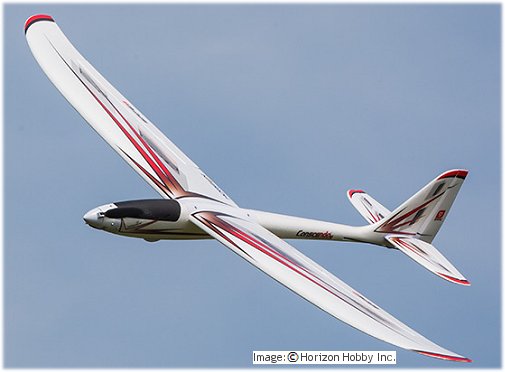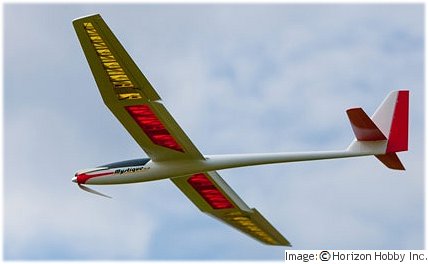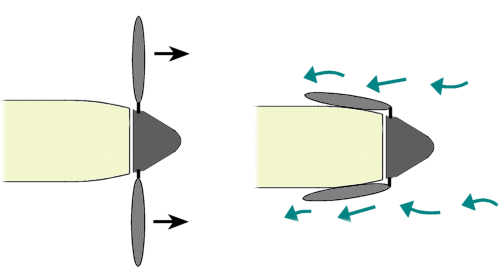For a gentle introduction to radio control flying, rc powered Gliders are an ideal answer; their stable and forgiving flight characteristics make them good for beginners to the hobby.
But what is a powered glider?
Also called a motor glider or e-soarer, this aircraft type is essentially a standard glider design with a motor added. The motor can be in the nose like a conventional plane, behind the wing on a pod, or can be a ‘pop up/fold away’ motor on a support that folds down into the fuselage when not in use, again behind the wing.
Nose-mounted motors turn a folding propeller, and this is key to reducing drag when the power is switched off.
For beginners to the hobby, the Hobbyzone Conscendo is an excellent introduction to powered gliders. With its SAFE™ technology, it’s been designed to make learning to fly one of these gentle gliders as easy as possible.

SAFE technology gives you two levels of electronic stabilization, or can be deactivated completely. These options, coupled with the inherent stability of the glider, really give the beginner rc pilot a fighting chance of having successful first flights!
Moving up in terms of control complexity, the ParkZone Radian Pro, shown below, has been a firm favourite for years. I’ve had one myself and can certainly recommend them.

The Radian Pro has a two meter wingspan, making it a good size powered glider capable of riding the thermals on a warm day. An rc powered glider like this will reward you with very long flight times, with careful use of the power and good soaring skills!
The RP isn’t particularly a beginner’s glider, since it has ‘full house’ wing features, but it is an excellent powered glider for intermediate pilots. At my soaring club competitions it has, on occasion, outperformed much more expensive rc powered gliders!
Moving up in size still, and away from foam construction, we have the popular E-flite Mystique, shown below. This is a powered glider with glass-fiber moulded fuselage and traditional built-up wings. At 2.9m wingspan it is ideal as a next step up from the foamie aircraft like the Radians, Multiplex Easy Star, Cularis etc.
A friend of mine has a Mystique and I sometimes fly it – it’s a beautiful flyer and performs exceptionally well on warm thermally days. Again, highly recommended!

Folding propellers.
RC powered gliders are equipped with a folding propeller to reduce drag when the motor is not in use.
The blades of the prop are hinged at the root, and when the motor is running the blades are in their normal forward position, thus pulling the glider through the air. But when the motor is shut off, the wind over the blades pushes them back so that they lie flat against the side of the nose of the glider, drastically reducing any unwanted drag while the glider is gliding.
Turn the power on again, and the blades flick out to generate thrust once more.

Above: the folding propeller blades of an rc powered glider at work: left, the blades in their normal positions when the motor is on, powering the glider through the air. Right, with the motor off the forward motion of the glider through the air pushes the blades back to lie flat against the nose, thus reducing drag.
Sometimes folding prop blades might refuse to fold back, and the trick here is to use an ESC with a brake function. If the blades do not fold back as they should, the prop will ‘windmill’ – turn freely in the air – and this creates a lot of drag, and hence the glide rate of the aircraft will be reduced.
An ESC brake will electronically stop the motor from turning, with the Tx stick fully down, and this will allow the prop blades to fold back.
Flying an RC powered glider.
RC powered gliders are, more often than not, very gentle birds. They have stable and forgiving flight characteristics, giving you plenty of time to react.
But the thing that makes them so attractive is the length of flight times possible; on a good day, flights of an hour might not be uncommon. You hand launch the glider with full power, and use the motor to climb to a good altitude. Once reached, turn the motor off and let the soaring capabilities take over.
With a nice steady breeze and good thermals around, the glider will stay aloft for as long as your soaring skills allow. When you’ve lost altitude, simply turn the motor back on and commence another climb, without landing. Repeating this process means that the motor battery pack won’t be drained quickly, and your flight will last and last, so long as you can continue to find any lift that’s around.
If there are a few of you flying together, why not hold a simple duration competition?
All you need to do is launch at the same time and to the same altitude (for example, have a 30-second motor run), switch off the motor and stay up for as long as you can – the last one down wins! It’s a great way of enjoying some light-hearted competitive radio control flying with your friends, and it improves your flying skills too!
RC ‘Hotliners’
The so-called ‘hotliners’ are essentially rc powered gliders with extra muscle!
The configuration is the same but the aircraft are sleeker and have more powerful motors. As a result, they fly a lot faster, as the video below shows…
Hotliners aren’t for beginners because of their speed – you need good reactions and co-ordination, both which take time to develop when learning to fly a radio control plane.
Conventional RC powered gliders are, in my opinion, one of the best introductions to powered rc flight available. And they give you the best of both worlds; power when you need it, a glider when you don’t!
If you’re looking for some relaxing and easy radio control flying, a powered glider is without doubt the answer, and in my opinion is one of the nicest type of rc planes to fly.


online prescriptions without a doctor
canadapharmacy com
best online pharmacies no prescription
price prescription drugs
canadian rx pharmacy online
canadian xanax
price prescription drugs
how to take sildenafil 20 mg
sildenafil nitrate
canadian pharmaceuticals online safe
I will immediately clutch your rss feed as I can’t find your email subscription link or e-newsletter service.
Do you’ve any? Please permit me recognise in order that I may just subscribe.
Thanks.
generic cialis tadalafil
https://gajweor.pixnet.net/blog/post/157629283
https://vermilion-elephant-dd3cm3.mystrikingly.com/blog/1ed0baf6713
https://umber-elk-dbgzh8.mystrikingly.com/blog/73b5fec01e3
https://naveridbuy.exblog.jp/35878171/
https://naveridbuy.exblog.jp/35659068/
https://gajweor.pixnet.net/blog/post/162874708
https://ko.anotepad.com/note/read/mmapaiwr
https://medium.com/@carlfrancoh38793/%EB%84%A4%EC%9D%B4%EB%B2%84-%EC%95%84%EC%9D%B4%EB%94%94-%ED%8C%90%EB%A7%A4%EC%99%80-%EA%B5%AC%EB%A7%A4-%EB%B2%95%EC%A0%81-%EB%A6%AC%EC%8A%A4%ED%81%AC%EC%99%80-%EC%95%88%EC%A0%84%ED%95%9C-%EA%B1%B0%EB%9E%98-%EB%B0%A9%EB%B2%95-be7d61cdbe03
https://vermilion-elephant-dd3cm3.mystrikingly.com/blog/e0d4542898d
https://medium.com/@1kelly76/%EB%B0%9C%EA%B8%B0%EB%B6%80%EC%A0%84%EA%B3%BC-%EC%A1%B0%EB%A3%A8-%EC%9B%90%EC%9D%B8%EA%B3%BC-%ED%95%B4%EA%B2%B0%EC%B1%85-%EC%99%84%EB%B2%BD-%EA%B0%80%EC%9D%B4%EB%93%9C-f2bce7dc7851
https://xn--w3-hd0jg6f81lm0dhhw74c.mystrikingly.com/blog/633b5d0c891
https://zippy-tomato-dbgzhv.mystrikingly.com/blog/b0c4e583f8a
https://naveridbuy.blogspot.com/2024/09/blog-post_62.html
https://gajweor.pixnet.net/blog/post/175638916
https://ocher-alligator-dc4vlx.mystrikingly.com/blog/d77159a0dae
https://gajweor.pixnet.net/blog/post/157629283
https://medium.com/@nsw5288/%EB%B9%84%EC%95%84%EA%B7%B8%EB%9D%BC%EC%99%80-%EB%B9%84%EC%95%84%EA%B7%B8%EB%9D%BC-%EC%A0%9C%EB%84%A4%EB%A6%AD-%EB%AC%B4%EC%97%87%EC%9D%84-%EC%84%A0%ED%83%9D%ED%95%A0%EA%B9%8C-145e148e19c8
https://xn--w9-hd0jg6f81lm0dhhw74c.mystrikingly.com/blog/e32821ddd5b
https://medium.com/@nsw5288/%EB%82%A8%EC%84%B1-%EC%84%B1%EA%B8%B0%EB%8A%A5-%EB%AC%B8%EC%A0%9C-%ED%95%B4%EA%B2%B0-%EB%B0%9C%EA%B8%B0%EB%B6%80%EC%A0%84%EA%B3%BC-%EC%A1%B0%EB%A3%A8-%EC%98%88%EB%B0%A9-%EA%B0%80%EC%9D%B4%EB%93%9C-24b1c1e6e230
https://xn--gc-2e2i723b91ktjas9l307b.mystrikingly.com/blog/802294b3778
https://vermilion-elephant-dd3cm3.mystrikingly.com/blog/1f118741896
https://naveridbuy.exblog.jp/36061485/
https://aqua-anemone-dbgzh3.mystrikingly.com/blog/fb2c3e24d26
https://medium.com/@nsw5288/%EB%B9%84%EC%95%84%EA%B7%B8%EB%9D%BC%EC%9D%98-%EB%B6%80%EC%9E%91%EC%9A%A9%EA%B3%BC-%EC%95%88%EC%A0%84%ED%95%98%EA%B2%8C-%EB%B3%B5%EC%9A%A9%ED%95%98%EB%8A%94-%EB%B0%A9%EB%B2%95-7b4396b87ed1
https://telegra.ph/%EB%B9%84%EC%95%84%EA%B7%B8%EB%9D%BC-%EC%98%A8%EB%9D%BC%EC%9D%B8-%EA%B5%AC%EB%A7%A4-%ED%9B%84%EA%B8%B0%EC%99%80-%EC%A3%BC%EC%9D%98%ED%95%B4%EC%95%BC-%ED%95%A0-%EC%A0%90%EB%93%A4-09-20
https://naveridbuy.exblog.jp/35891783/
https://responsible-seal-dd3cm4.mystrikingly.com/blog/247a7d18ce0
https://medium.com/@charlielevesque328/%EB%B9%84%EC%95%84%EA%B7%B8%EB%9D%BC-%EA%B5%AC%EB%A7%A4-%ED%9B%84-%EC%82%AC%EC%9A%A9%EB%B2%95-%ED%9A%A8%EA%B3%BC%EC%A0%81%EC%9D%B8-%ED%99%9C%EC%9A%A9%EB%B2%95-7a48906d3d2c
sildenafil cvs
https://aquamarine-magnolia-dc4vlj.mystrikingly.com/blog/71317ede0ec
https://viastoer.blogspot.com/2024/09/blog-post_80.html
https://xn--w6-o02ik82a9kav54aokmxvc.mystrikingly.com/blog/vs
https://sociable-corn-dd3cmt.mystrikingly.com/blog/f07125d1958
https://maize-wombat-dd3cms.mystrikingly.com/blog/7469615120c
https://sociable-corn-dd3cmt.mystrikingly.com/blog/64a51123d6d
https://xn--ga-2e2i723b91ktjas9l307b.mystrikingly.com/blog/05a4a7b59bd
https://diplomatic-shrimp-dbgzh2.mystrikingly.com/blog/079e4cac293
https://naveridbuy.blogspot.com/2024/07/blog-post_70.html
https://ganghwamarathon.co.kr/bbs/board.php?bo_table=board03_8008&wr_id=261789
https://www.ninersnation.com/users/carlfrancoh38793
https://telegra.ph/%EB%B9%84%EC%95%84%EA%B7%B8%EB%9D%BC-%EA%B0%80%EA%B2%A9%EA%B3%BC-%ED%9A%A8%EA%B3%BC-%EC%A0%9C%EB%8C%80%EB%A1%9C-%EC%95%8C%EA%B3%A0-%EA%B5%AC%EB%A7%A4%ED%95%98%EA%B8%B0-07-31
https://xn--w4-hs1izvv81cmb366re3s.mystrikingly.com/blog/6ae78fa4b70
https://gajweor.pixnet.net/blog/post/162189190
https://gajweor.pixnet.net/blog/post/162315976
https://salmon-peach-dd3cm8.mystrikingly.com/blog/vs
https://hallbook.com.br/blogs/300837/%EB%B9%84%EC%95%84%EA%B7%B8%EB%9D%BC-%EC%B2%98%EB%B0%A9%EC%A0%84-%EC%97%86%EC%9D%B4-%EA%B5%AC%EB%A7%A4%ED%95%98%EB%8A%94-%EB%B0%A9%EB%B2%95%EA%B3%BC-%EB%A6%AC%EC%8A%A4%ED%81%AC
https://medium.com/@charlielevesque328/%EB%B9%84%EC%95%84%EA%B7%B8%EB%9D%BC-%EA%B5%AC%EB%A7%A4-%EA%B0%80%EA%B2%A9-%ED%92%88%EC%A7%88-%EC%95%88%EC%A0%84%EC%84%B1%EC%9D%84-%EB%AA%A8%EB%91%90-%EA%B3%A0%EB%A0%A4%ED%95%98%EC%9E%90-ad89a243bd5a
https://cinnamon-carnation-dbgzh6.mystrikingly.com/blog/1d8602d8d6c
https://medium.com/@nsw5288/%EC%88%A0%EB%A8%B9%EA%B3%A0-%EB%B9%84%EC%95%84%EA%B7%B8%EB%9D%BC-%EB%A8%B9%EC%9C%BC%EB%A9%B4-0ca4af2b21cd
https://writeablog.net/mqcuo9vdox
https://wise-onion-dbgzhg.mystrikingly.com/blog/fc93a4ca9ec
https://telegra.ph/%EB%B9%84%EC%95%84%EA%B7%B8%EB%9D%BC-%EA%B5%AC%EB%A7%A4-%EC%8B%9C-%EA%BC%AD-%EC%95%8C%EC%95%84%EC%95%BC-%ED%95%A0-%EB%B2%95%EC%A0%81-%EC%82%AC%ED%95%AD-07-23
https://www.mmafighting.com/users/carlfrancoh38793
https://gajweor.pixnet.net/blog/post/157629430
https://gajweor.pixnet.net/blog/post/162317545
https://xn--w0-hd0j99gyns5z0qeiim2i.mystrikingly.com/blog/41cd67e48ef
https://telegra.ph/%EB%B9%84%EC%95%84%EA%B7%B8%EB%9D%BC-%EA%B5%AC%EB%A7%A4-%EA%B0%80%EC%9D%B4%EB%93%9C-%EC%95%88%EC%A0%84%ED%95%98%EA%B3%A0-%EC%A0%80%EB%A0%B4%ED%95%98%EA%B2%8C-%EA%B5%AC%EB%A7%A4%ED%95%98%EB%8A%94-%EB%B0%A9%EB%B2%95-09-26
https://medium.com/@dqvchristopherwhite824/%EB%84%A4%EC%9D%B4%EB%B2%84-%EC%8B%A4%EB%AA%85-%EC%95%84%EC%9D%B4%EB%94%94-%EA%B5%AC%EB%A7%A4-56a09b77144c
https://cinnamon-carnation-dbgzh6.mystrikingly.com/blog/1d8602d8d6c
https://gajweor.pixnet.net/blog/post/162874531
https://xn--w0-hd0jg6f81lm0dhhw74c.mystrikingly.com/blog/2ea87cc6ee1
https://xn--fw-hd0jg6f81ltjas9lbns.mystrikingly.com/blog/e206d805c64
https://ask-people.net/user/naveridbuy
https://ameblo.jp/naveridbuy/entry-12861932515.html
https://medium.com/@nsw5288/%EB%B9%84%EC%95%84%EA%B7%B8%EB%9D%BC%EC%99%80-%ED%95%A8%EA%BB%98%EB%9D%BC%EB%A9%B4-%EC%A3%BC%EC%9D%98%ED%95%B4%EC%95%BC-%ED%95%A0-%EC%95%BD%EB%AC%BC%EB%93%A4-a3861b835e15
https://hallbook.com.br/blogs/278113/%EB%B9%84%EC%95%84%EA%B7%B8%EB%9D%BC-%EA%B5%AC%EB%A7%A4-%EC%98%A4%ED%94%84%EB%9D%BC%EC%9D%B8-%EC%95%BD%EA%B5%AD%EA%B3%BC-%EC%98%A8%EB%9D%BC%EC%9D%B8-%EC%87%BC%ED%95%91%EC%9D%98-%EC%9E%A5%EB%8B%A8%EC%A0%90
https://medium.com/@1kelly76/%EB%B9%84%EC%95%84%EA%B7%B8%EB%9D%BC-%EA%B5%AC%EB%A7%A4-%ED%9B%84-%EB%B6%80%EC%9E%91%EC%9A%A9-%EB%8C%80%EC%B2%98%EB%B2%95-52675767f799
https://xn--w1-hd0j99gyns5z0qeiim2i.mystrikingly.com/blog/0f0c3c2cbe2
https://telegra.ph/%EB%B9%84%EC%95%84%EA%B7%B8%EB%9D%BC-%EA%B5%AC%EB%A7%A4-%EC%8B%9C-%ED%95%84%EC%88%98-%EC%B2%B4%ED%81%AC%EB%A6%AC%EC%8A%A4%ED%8A%B8-10-10
https://medium.com/@nsw5288/%EB%B9%84%EC%95%84%EA%B7%B8%EB%9D%BC-%EA%B5%AC%EB%A7%A4-%EC%A0%84-%EC%95%8C%EC%95%84%EC%95%BC-%ED%95%A0-%EB%B2%95%EC%A0%81-%EC%82%AC%ED%95%AD%EA%B3%BC-%EC%A0%88%EC%B0%A8-8cd85787102b
https://xn--w3-hs1izvv81cmb366re3s.mystrikingly.com/blog/798b402f072
https://medium.com/@dqvchristopherwhite824/%EB%84%A4%EC%9D%B4%EB%B2%84-%EC%95%84%EC%9D%B4%EB%94%94-%EA%B5%AC%EB%A7%A4-%ED%9B%84-sns-%EC%97%B0%EB%8F%99-%EB%B0%A9%EB%B2%95-9a8c1c76fe8a
https://gajweor.pixnet.net/blog/post/157629148
https://telegra.ph/%EB%B9%84%EC%95%84%EA%B7%B8%EB%9D%BC-%EC%98%A8%EB%9D%BC%EC%9D%B8-%EA%B5%AC%EB%A7%A4-%ED%9B%84%EA%B8%B0%EC%99%80-%EC%A3%BC%EC%9D%98%ED%95%B4%EC%95%BC-%ED%95%A0-%EC%A0%90%EB%93%A4-09-20
https://xn--w9-hs1izvv81cmb366re3s.mystrikingly.com/blog/c79c96dc746
https://responsible-seal-dd3cm4.mystrikingly.com/blog/adac0a7d1b7
https://golden-giraffe-dbgzhj.mystrikingly.com/blog/4073661591e
https://gajweor.pixnet.net/blog/post/157629148
https://ameblo.jp/naveridbuy/entry-12866333257.html
https://telegra.ph/%ED%8A%B8%EC%9C%84%ED%84%B0-%EC%95%84%EC%9D%B4%EB%94%94-%EA%B1%B0%EB%9E%98%EC%9D%98-%EC%9E%A5%EB%8B%A8%EC%A0%90%EA%B3%BC-%EC%95%88%EC%A0%84%ED%95%98%EA%B2%8C-%EA%B1%B0%EB%9E%98%ED%95%98%EB%8A%94-%EB%B2%95-09-12
https://hallbook.com.br/blogs/326301/%EB%B9%84%EC%95%84%EA%B7%B8%EB%9D%BC-%EA%B5%AC%EB%A7%A4-%ED%9B%84-%EC%A0%95%ED%92%88-%ED%99%95%EC%9D%B8%ED%95%98%EB%8A%94-5%EA%B0%80%EC%A7%80-%EB%B0%A9%EB%B2%95
https://xn--w9-o02ik82a9zf22ad8ev5v7ld1xt.mystrikingly.com/blog/vs
https://gajweor.pixnet.net/blog/post/164186431
https://tawny-wombat-dd3cmn.mystrikingly.com/blog/4cd329160f9
https://medium.com/@1kelly76/%EB%B9%84%EC%95%84%EA%B7%B8%EB%9D%BC-%EA%B5%AC%EB%A7%A4-%ED%9B%84-%EC%A0%95%ED%92%88-%ED%99%95%EC%9D%B8%ED%95%98%EB%8A%94-5%EA%B0%80%EC%A7%80-%EB%B0%A9%EB%B2%95-280d22e7ac38
https://medium.com/@nsw5288/%EB%B9%84%EC%95%84%EA%B7%B8%EB%9D%BC-%EA%B5%AC%EB%A7%A4-%EC%A0%84-%EC%95%8C%EC%95%84%EC%95%BC-%ED%95%A0-%EB%B2%95%EC%A0%81-%EC%82%AC%ED%95%AD%EA%B3%BC-%EC%A0%88%EC%B0%A8-8cd85787102b
https://maize-wombat-dd3cms.mystrikingly.com/blog/90c3ba770c0
https://naveridbuy.exblog.jp/35891806/
https://faithful-watermelon-dc4vlp.mystrikingly.com/blog/6ce5c665e16
https://medium.com/@carlfrancoh38793/%EB%84%A4%EC%9D%B4%EB%B2%84-%EC%95%84%EC%9D%B4%EB%94%94-%EA%B5%AC%EB%A7%A4-%EC%96%B4%EB%96%A4-%EC%A0%95%EB%B3%B4%EB%A5%BC-%EC%95%8C%EC%95%84%EC%95%BC-%ED%95%A0%EA%B9%8C-682c9cc6bc54
https://hallbook.com.br/blogs/313000/%EC%89%BD%EA%B3%A0-%EB%B9%A0%EB%A5%B8-%EB%84%A4%EC%9D%B4%EB%B2%84-%EC%95%84%EC%9D%B4%EB%94%94-%EA%B5%AC%EB%A7%A4-%EB%B0%A9%EB%B2%95
https://ko.anotepad.com/note/read/b2da9285
https://carmine-jasmine-dc4vlk.mystrikingly.com/blog/437ee4f9364
https://medium.com/@nsw5288/%EB%B0%9C%EA%B8%B0%EB%B6%80%EC%A0%84%EA%B3%BC-%EC%A1%B0%EB%A3%A8-%EC%89%BD%EA%B2%8C-%EC%9D%B4%ED%95%B4%ED%95%98%EA%B3%A0-%EA%B7%B9%EB%B3%B5%ED%95%98%EB%8A%94-%EB%B2%95-5212fd7c4fa0
https://xn--w0-hd0jg6f81lm0dhhw74c.mystrikingly.com/blog/2ea87cc6ee1
https://gajweor.pixnet.net/blog/post/162874435
https://adaptable-goat-dd3cmf.mystrikingly.com/blog/c2a25554bec
https://naveridbuy.blogspot.com/2024/10/faq.html
https://naveridbuy.exblog.jp/36061468/
https://gajweor.pixnet.net/blog/post/157629283
https://xn--w5-hd0jg6f81lm0dhhw74c.mystrikingly.com/blog/7dbe3159553
https://gajweor.pixnet.net/blog/post/164186431
https://gajweor.pixnet.net/blog/post/162317122
https://naveridbuy.blogspot.com/2024/08/blog-post_48.html
https://telegra.ph/%EB%84%A4%EC%9D%B4%EB%B2%84-%ED%86%A1%ED%86%A1%EC%9C%BC%EB%A1%9C-%EA%B3%A0%EA%B0%9D-%EC%86%8C%ED%86%B5%EC%9D%84-%EA%B0%95%ED%99%94%ED%95%98%EB%8A%94-%EB%B0%A9%EB%B2%95-08-28
https://xn--w1-hs1izvv81cmb366re3s.mystrikingly.com/blog/ff9be9fe35c
https://medium.com/@nsw5288/%EC%B2%98%EB%B0%A9%EC%A0%84-%EC%97%86%EC%9D%B4-%EB%B9%84%EC%95%84%EA%B7%B8%EB%9D%BC-%EA%B5%AC%EB%A7%A4-%EC%9C%84%ED%97%98%EC%84%B1%EA%B3%BC-%ED%95%A9%EB%B2%95%EC%84%B1-3bf901b3695b
https://writeablog.net/bzmd5ls4rc
https://medium.com/@charlielevesque328/%EB%B9%84%EC%95%84%EA%B7%B8%EB%9D%BC-%EA%B5%AC%EB%A7%A4-%EC%8B%9C-%EC%95%8C%EC%95%84%EC%95%BC-%ED%95%A0-%EC%9C%A0%EC%9D%98%EC%82%AC%ED%95%AD-7%EA%B0%80%EC%A7%80-65e6def5d880
https://medium.com/@nsw5288/%EB%B9%84%EC%95%84%EA%B7%B8%EB%9D%BC-%EB%8C%80%EC%B2%B4%EC%A0%9C%EC%99%80-%EB%B9%84%EA%B5%90-%ED%98%84%EB%AA%85%ED%95%9C-%EC%84%A0%ED%83%9D-%EA%B0%80%EC%9D%B4%EB%93%9C-b4f0c20e07fe
https://golden-giraffe-dbgzhj.mystrikingly.com/blog/1e90430597c
https://naveridbuy.blogspot.com/2024/09/blog-post_40.html
https://inky-lark-dc4vlz.mystrikingly.com/blog/17d9b1a7a56
https://medium.com/@nsw5288/%EB%B9%84%EC%95%84%EA%B7%B8%EB%9D%BC-%EA%B5%AC%EB%A7%A4-%EA%B0%80%EC%9D%B4%EB%93%9C-%EC%95%88%EC%A0%84%ED%95%98%EA%B3%A0-%EC%A0%80%EB%A0%B4%ED%95%98%EA%B2%8C-%EA%B5%AC%EB%A7%A4%ED%95%98%EB%8A%94-%EB%B0%A9%EB%B2%95-fbbad5bc4210
https://gajweor.pixnet.net/blog/post/157629706
https://ko.anotepad.com/note/read/8iqcnqkc
https://turquoise-dove-dd3cmd.mystrikingly.com/blog/1921e9ae6f5
https://viastoer.blogspot.com/2024/10/5.html
https://viastoer.blogspot.com/2024/09/5.html
https://gajweor.pixnet.net/blog/post/157629706
https://ko.anotepad.com/note/read/nqx5wt7s
https://gajweor.pixnet.net/blog/post/164186431
https://medium.com/@dqvchristopherwhite824/%EB%84%A4%EC%9D%B4%EB%B2%84-%EC%95%84%EC%9D%B4%EB%94%94-%ED%8C%90%EB%A7%A4-%EC%8B%9C-%EC%A3%BC%EC%9D%98%ED%95%B4%EC%95%BC-%ED%95%A0-%EB%B2%95%EC%A0%81-%EB%AC%B8%EC%A0%9C-fc4806acde8d
https://medium.com/@dqvchristopherwhite824/%EC%9C%A0%ED%8A%9C%EB%B8%8C-%EC%A1%B0%ED%9A%8C%EC%88%98-%EC%B9%B4%EC%9A%B4%ED%8C%85-%EA%B8%B0%EC%A4%80-132cfe1f722d
https://ko.anotepad.com/note/read/jbd5a5sa
https://adaptable-goat-dd3cmf.mystrikingly.com/blog/a785156fd6e
https://hypothes.is/users/idmall
https://medium.com/@nsw5288/%EB%B9%84%EC%95%84%EA%B7%B8%EB%9D%BC-%EB%A8%B9%EC%9C%BC%EB%A9%B4-%EB%82%98%ED%83%80%EB%82%98%EB%8A%94-%EC%A6%9D%EC%83%81-2ababd9c0624
https://medium.com/@nsw5288/%EB%B9%84%EC%95%84%EA%B7%B8%EB%9D%BC-%EC%82%AC%EC%9A%A9%EB%B2%95%EA%B3%BC-%EB%B6%80%EC%9E%91%EC%9A%A9%EC%9D%80-916393446295
https://viastoer.blogspot.com/2024/10/5.html
https://vermilion-elephant-dd3cm3.mystrikingly.com/blog/cda35b98376
https://sorrel-coconut-dc4vln.mystrikingly.com/blog/4f77db37ced
https://telegra.ph/%EB%B9%84%EC%95%84%EA%B7%B8%EB%9D%BC-%EA%B0%80%EA%B2%A9%EA%B3%BC-%ED%9A%A8%EA%B3%BC-%EC%A0%9C%EB%8C%80%EB%A1%9C-%EC%95%8C%EA%B3%A0-%EA%B5%AC%EB%A7%A4%ED%95%98%EA%B8%B0-07-31
https://medium.com/@nsw5288/%EB%B9%84%EC%95%84%EA%B7%B8%EB%9D%BC%EC%99%80-%ED%95%A8%EA%BB%98%EB%9D%BC%EB%A9%B4-%EC%A3%BC%EC%9D%98%ED%95%B4%EC%95%BC-%ED%95%A0-%EC%95%BD%EB%AC%BC%EB%93%A4-a3861b835e15
https://www.xn--ob0bp9ft7puza.com/bbs_shop/read.htm?me_popup=0&auto_frame=&cate_sub_idx=0&search_first_subject=&list_mode=board&board_code=board1&search_key=&key=&page=0&idx=10396
https://competent-taro-dc4vl1.mystrikingly.com/blog/5e83e0a1d96
https://medium.com/@dqvchristopherwhite824/%EB%84%A4%EC%9D%B4%EB%B2%84-%EC%95%84%EC%9D%B4%EB%94%94%EB%A5%BC-%EA%B5%AC%EB%A7%A4%ED%95%A0-%EB%95%8C-%EC%82%AC%EA%B8%B0-%EC%98%88%EB%B0%A9-%ED%8C%81-3f467087fdee
https://gajweor.pixnet.net/blog/post/157629580
https://www.sbnation.com/users/naveridbuy
https://xn--lb-o02ik82aiqcqsko8mfg5a1sb.mystrikingly.com/blog/3e5334cf6b6
https://xn--w9-o02ik82a9kav54aokmxvc.mystrikingly.com/blog/4724d879be1
https://umber-iris-dd3cm2.mystrikingly.com/blog/674c3251b7d
https://ko.anotepad.com/note/read/pymsgn44
https://hallbook.com.br/blogs/313105/%EB%B9%84%EC%95%84%EA%B7%B8%EB%9D%BC-%EC%A0%9C%EB%84%A4%EB%A6%AD-%EC%A0%9C%ED%92%88-%EA%B0%80%EA%B2%A9%EA%B3%BC-%ED%9A%A8%EA%B3%BC-%EB%B9%84%EA%B5%90
https://naveridbuy.blogspot.com/2024/08/blog-post_28.html
https://xn--w6-hd0j99gyns5z0qeiim2i.mystrikingly.com/blog/f33715c06a4
https://punctual-rabbit-dc4vlv.mystrikingly.com/blog/1fe12d20601
https://zippy-tomato-dbgzhv.mystrikingly.com/blog/b0c4e583f8a
https://3dwarehouse.sketchup.com/by/idmall
https://umber-koala-dc4vl3.mystrikingly.com/blog/1b6fa0818b0
https://www.bloggingthebracket.com/users/carlfrancoh38793
https://gajweor.pixnet.net/blog/post/162189334
https://just-coconut-dc4vlw.mystrikingly.com/blog/083bcdd53ce
https://telegra.ph/%EB%B9%84%EC%95%84%EA%B7%B8%EB%9D%BC-%EA%B5%AC%EB%A7%A4-%ED%8C%81-%ED%95%A9%EB%A6%AC%EC%A0%81%EC%9D%B8-%EA%B0%80%EA%B2%A9%EC%97%90-%EA%B5%AC%EC%9E%85%ED%95%98%EB%8A%94-%EB%B2%95-07-23
https://viastoer.blogspot.com/2024/09/blog-post_14.html
https://viastoer.blogspot.com/2024/07/blog-post_86.html
https://www.producthunt.com/@naveridbuy
https://naveridbuy.exblog.jp/35659139/
https://gajweor.pixnet.net/blog/post/162317287
https://xn--w4-hs1izvv81cmb366re3s.mystrikingly.com/blog/6ae78fa4b70
https://gajweor.pixnet.net/blog/post/157629148
https://ameblo.jp/naveridbuy/entry-12865282919.html
https://ameblo.jp/naveridbuy/entry-12865279679.html
https://xn--w8-o02ik82a9kav54aokmxvc.mystrikingly.com/blog/9743f076767
https://medium.com/@1kelly76/%EB%B9%84%EC%95%84%EA%B7%B8%EB%9D%BC-%EA%B5%AC%EB%A7%A4%EC%99%80-%EC%82%AC%EC%9A%A9-%EC%8B%9C-%ED%94%BC%ED%95%B4%EC%95%BC-%ED%95%A0-%EC%8B%A4%EC%88%98-2f8d1110324c
https://hallbook.com.br/blogs/300850/%EB%B9%84%EC%95%84%EA%B7%B8%EB%9D%BC%EC%9D%98-%EC%84%B1%EB%B6%84%EA%B3%BC-%ED%9A%A8%EA%B3%BC-%EC%A0%95%ED%99%95%ED%9E%88-%EC%95%8C%EA%B8%B0-%EC%9C%84%ED%95%9C-%EA%B5%AC%EB%A7%A4-%EC%A0%84-%EC%B2%B4%ED%81%AC%EC%82%AC%ED%95%AD
canada pharmacy online
sildenafil price
http://terios2.ru/forums/index.php?autocom=gallery&req=si&img=4544
I always emailed this web site post page to all my contacts, for the reason that if
like to read it after that my friends will too.
My brother recommended I might like this blog.
He was totally right. This post truly made my day.
You cann’t imagine just how much time I had spent for this information! Thanks!
I love what you guys are up too. Such clever work and coverage!
Keep up the very good works guys I’ve incorporated you guys to our blogroll.
Greetings from Carolina! I’m bored to death at work so
I decided to check out your blog on my iphone during lunch break.
I really like the knowledge you present here and
can’t wait to take a look when I get home. I’m amazed at how fast your blog loaded on my cell phone ..
I’m not even using WIFI, just 3G .. Anyways, wonderful site!
Howdy are using WordPress for your site platform? I’m new to the blog world but I’m trying to
get started and create my own. Do you require any coding knowledge to make your own blog?
Any help would be greatly appreciated!
https://mazda-demio.ru/forums/index.php?autocom=gallery&req=si&img=6358